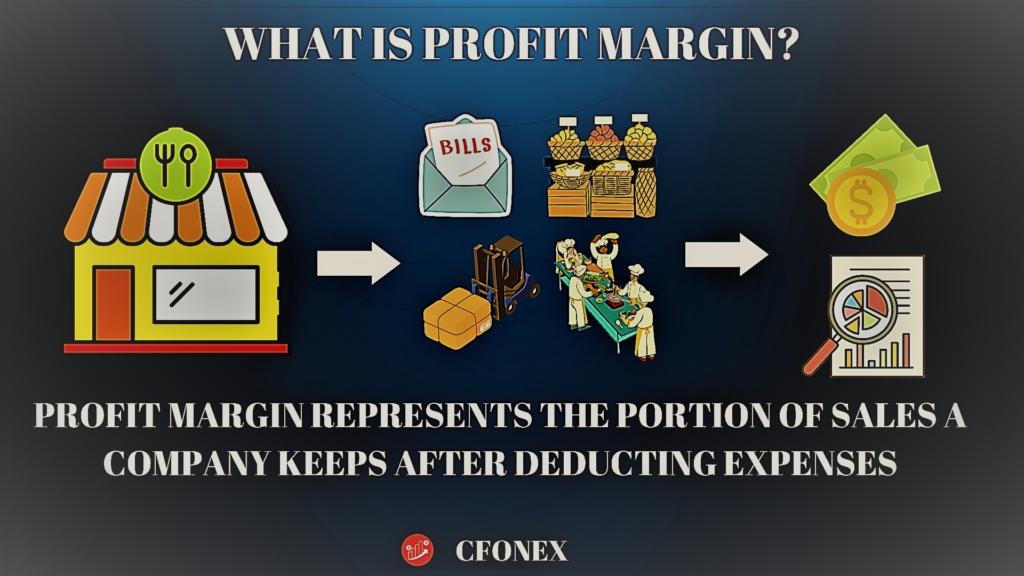Profit margin, expressed as a percentage, represents the portion of sales a company keeps as profit after deducting all expenses.

What is Profit Margin?
Profit margin is a key financial metric that measures the percentage of revenue a company keeps as a profit after subtracting all costs.
Profit is the money earned by a company when its total revenue exceeds its total expenses. Profit margin, on the other hand, is the profit that is stated as a percentage of revenue.
Understanding profit margin is important to manage the financial health of a company as it shows the profitability of a product, service, or a business.
Since profit margin is stated as a percentage of revenue, that means the higher the margin the, the more profitable for a company.
The benefits of profit margin for a company are:
- Used as a guide for decision-making process and overall strategies
- Helps in determining pricing problems
- Assists with cash flow strategies
- Useful for setting performance benchmark
Types and Calculation of Profit Margins
There are three main types of profit margin metrics that gives insights into the financial health of a company, and they are Gross Profit Margin, Operating Profit Margin, and Net Profit Margin:
1- Gross Profit Margin
Gross profit margin is a ratio that reveals the amount of money remaining after deducting the Cost of Goods Sold (COGS). The formula shows how much of every sale is available for a company to use in its operations.
The gross profit margin equation is typically used to determine the percentage of profit gained after deducting the production cost, known as the cost of goods sold (COGS).
Gross profit margin is calculated by subtracting the cost of goods sold (COGS) from total revenue and dividing the result by total revenue.
The formula for Gross Profit Margin is:
Gross Profit Margin = ((Total Revenue – COGS) / Total Revenue) * 100
Remember that Total Revenue – COGS = Gross Profit. So, we can state the gross profit margin formula as follows:
Gross Profit Margin = (Gross Profit/Total Revenue) * 100
And we multiply the formula by 100 to get the percentage hence the word margin in the gross profit margin (which states the profit as a percentage of revenue).
Gross Profit Margin Example
ABC Company manufacture sells medical gowns online. The revenue from selling medical gowns last year was $600,000, and the cost of goods sold was $200,000. The gross profit margin would be as follows:
(($600,000 -$200,00)/$600,000) * 100 = 67% gross profit margin
based on this, 67 cents of dollar ABC makes in sales is available to use to run the company’s operation.
2- Operating Profit Margin:
Operating profit margin is another measure of profitability that compares operating income (EBIT-earnings before interest and taxes-) to revenue.
Operating profit margin, also known as the Return on Sales, and expressed in percent as well accounts for all overhead costs, sales and operating expenses, administrative, depreciation, amortization but excludes taxes, debts, and other non-operational expenses.
Operating profit margin is calculated by dividing operating income by revenue and indicates how much of the generated sale is left when all operating expenses such as debt, taxes, and distribution to owners or shareholders are paid.
here’s the formula for operating profit margin:
(Operating Income/Revenue) * 100 = Operating Profit Margin
ABC Company has an operating income of $2,000,000 and a revenue of $5,000,000. The operating profit margin for ABC is:
(2,000,000 / $5,000,000) * 100 = 40% this means that ABC Company is able to earn 40% or 40 cents for every dollar the company makes. This also concludes that 60% or 60 cents of every sale goes to either producing the sale and/or operating the company.
Operating profit margin metric is important due to the following:
- Used as a comparison tool between companies in the same industry.
- Used to evaluate investment in the company by investors.
- Indicates whether the company is having issues or difficulties paying future expenses.
3- Net Profit Margin
Net profit margin is the top indicator of profitability that measures how much revenue is remaining after deducting all expenses (including COGS, operational expenses, taxes, and debts).
The formula for calculating net profit margin is:
Net Profit Margin = (Net Profit / Net Sales) * 100
ABC company has a net profit of $750,000, for example, and net sales in the amount of $3,500,000. The net profit margin for ABC is
($750,000 / $3,500,000) * 100 = 21%
ABC Company can retain 20% of its revenue as a profit after deducting all operating and non-operating expenses.
Leave a Reply